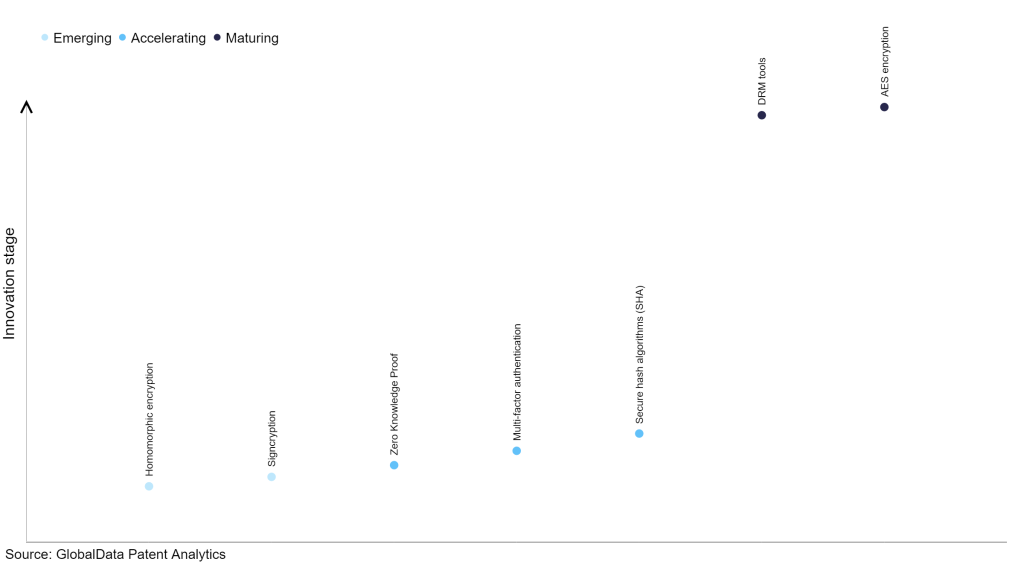The technology industry continues to be a hotbed of patent innovation. Activity is driven by the increasing concerns over data breaches and cyber threats, as well as regulatory requirements for enhanced security measures, and growing importance of technologies such as advanced encryption algorithms, secure boot mechanisms, and secure key management protocols. These technologies collectively contribute to establishing a trusted computing environment and protecting critical systems and data from potential attacks. In the last three years alone, there have been over 1.5 million patents filed and granted in the technology industry, according to GlobalData’s report on Cybersecurity in technology: trusted platform modules. Buy the report here.
However, not all innovations are equal and nor do they follow a constant upward trend. Instead, their evolution takes the form of an S-shaped curve that reflects their typical lifecycle from early emergence to accelerating adoption, before finally stabilizing and reaching maturity.
Identifying where a particular innovation is on this journey, especially those that are in the emerging and accelerating stages, is essential for understanding their current level of adoption and the likely future trajectory and impact they will have.
185+ innovations will shape the technology industry
According to GlobalData’s Technology Foresights, which plots the S-curve for the technology industry using innovation intensity models built on over 1.6 million patents, there are 185+ innovation areas that will shape the future of the industry.
Within the emerging innovation stage, homomorphic encryption and signcryption, are disruptive technologies that are in the early stages of application and should be tracked closely. Zero knowledge proof, multi-factor authentication and secure hash algorithms (SHA) are some of the accelerating innovation areas, where adoption has been steadily increasing. Among maturing innovation areas are DRM tools and AES encryption, which are now well established in the industry.
Innovation S-curve for cybersecurity in the technology industry

Trusted platform modules is a key innovation area in cybersecurity
Trusted platform modules (TPMs) are dedicated hardware components that ensure the secure storage of encryption keys, passwords, and digital certificates. Their primary purpose is to offer a tamper-resistant environment for critical operations such as key generation, encryption, and decryption. TPMs are commonly employed for authentication, digital signatures, and safeguarding data from unauthorized access.
GlobalData’s analysis also uncovers the companies at the forefront of each innovation area and assesses the potential reach and impact of their patenting activity across different applications and geographies. According to GlobalData, there are 215 companies, spanning technology vendors, established technology companies, and up-and-coming start-ups engaged in the development and application of trusted platform modules.
Key players in trusted platform modules – a disruptive innovation in the technology industry
‘Application diversity’ measures the number of applications identified for each patent. It broadly splits companies into either ‘niche’ or ‘diversified’ innovators.
‘Geographic reach’ refers to the number of countries each patent is registered in. It reflects the breadth of geographic application intended, ranging from ‘global’ to ‘local’.
Patent volumes related to trusted platform modules
Source: GlobalData Patent Analytics
Microsoft is the leading patent filer in trusted platform modules. One of the company’s patents describes how in a multi-tenancy environment, a secure approach is employed to mitigate potential conflicts between tenants from different trust domains. By running tenants within a dedicated trust boundary component, security measures are implemented to prevent hostility between tenants. This system includes pre-prepared trust boundary components that can be quickly initiated, allowing for efficient establishment of trust boundaries while ensuring both security and low latency. Additionally, resource containers are used to effectively allocate resources among processes within the trust boundary component.
Other prominent patent filers in the space include Intel and International Business Machines (IBM).
By geographic reach, Panasonic leads the pack, followed by InterDigital and Sysdig. In terms of application diversity, Microsoft holds the top position, followed by Alphabet and Intel.
Cybersecurity innovation in trusted platform modules (TPMs) helps to enhance the security of digital systems. TPMs provide a dedicated hardware solution for storing sensitive information such as encryption keys, passwords, and digital certificates, ensuring their protection from unauthorized access and tampering. By incorporating TPMs into various devices and systems, cybersecurity is strengthened, enabling secure operations such as authentication, digital signing, and data protection.
To further understand how cybersecurity is disrupting the technology industry, access GlobalData’s latest thematic research report on Cybersecurity.
Data Insights
From

The gold standard of business intelligence.
Blending expert knowledge with cutting-edge technology, GlobalData’s unrivalled proprietary data will enable you to decode what’s happening in your market. You can make better informed decisions and gain a future-proof advantage over your competitors.







